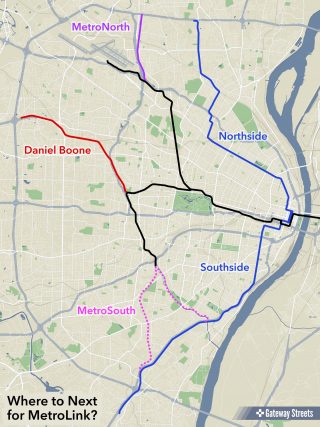With the passage of Proposition A, expansion of MetroLink is a real possibility. The sales tax increase has allowed Metro to escape a “death spiral” and has put the agency on a firm financial footing. The question everyone is asking, therefore, is where should MetroLink go next?
The recent Moving Transit Forward plan put forth by Metro and East-West Gateway provides a menu of options for expanding MetroLink within Missouri. However, Metro has also stated that MetroLink expansion will not occur without federal aid. That means environmental impact studies (EIS) will be required for each potential corridor.

Below is a look at the five potential MetroLink corridors mentioned in the Moving Transit Forward plan and the level of planning that has occurred for each one. Reports for some of the corridors can be found on East-West Gateway’s website.
Northside-Southside has the most fully developed plans of all MetroLink corridors. It was also the most highly favored corridor in Moving Transit Forward public meetings throughout the region. An Alternatives Analysis for Northside-Soutside was completed November 2008 and several station area development plans have been evaluated. This entirely new line would stretch up to 17 miles from downtown north to I-70 & Goodfellow via Natural Bridge and south to I-55 & Bayless via Jefferson and I-55. Its cost is estimated at $971 million (2007 dollars) with an expected ridership of 14,913 trips per day. An EIS study is likely still needed before this project can move forward.
MetroSouth would extend the Blue Line from its terminus in Shrewsbury to as far as I-55 & Butler Hill. A draft EIS was completed back in 2005, but did not select a locally preferred alternative. The two major options on the table include extending MetroLink via the Union Pacific railroad corridor or via the River Des Peres and I-55. One option is more direct whereas the other integrates quicker with the potential Southside corridor. The age of the draft EIS means it will likely require updating before a corridor can finally be chosen. Its cost is estimated at $586 – $700 million (2010 dollars) with an expected ridership of 9,100 – 9,600 trips per day, depending on the corridor chosen.
The Daniel Boone corridor had a preliminary MTIA study completed in 2000, a study that looked at a wide swath of west St. Louis County. This study selected an alignment out to Westport from Clayton via I-170 and the Terminal Railroad while simultaneously rejecting a parallel alignment along I-64. This corridor is widely thought to be St. Louis County’s first priority due to the proclamations made by County Executive Dooley in the lead up to the Proposition M vote in 2008. Such proclamations were notably absent during the recent Proposition A campaign replaced, instead, with a promise to judge each corridor based on its merits. An EIS would still need to be performed before federal funding could be pursued for this corridor.
MetroNorth would branch off the existing Red Line at North Hanley and follow I-170 north to Florissant. No planning has yet been performed on this corridor.
Madison County completed a feasibility study in 2004 that identified several possible MetroLink corridors in the area that extended as far as Alton and Edwardsville. A minimum build option would extend MetroLink only 4 miles into the Tri-Cities area. This option would cost about $160 million (2005 dollars) and attract an estimated 7,000 daily passengers. Madison County, however, lacks a local source of funding. Voters rejected a sales tax increase back in 2004 that would have paid for such an expansion.

The Northside-Southside line is a no-brainer, and should absolutely be pursued before any other extension. The City of St. Louis has the greatest population density, the highest percentage of residents who depend on transit, and transit-oriented infrastructure (walkable neighborhoods and commercial districts) already in place. Any great city would make its urban neighborhoods a priority before expanding in far-flung, low-density suburbs. It would be wasteful and backwards to not focus on a Northside-Southside corridor first.
Don't forget there is an MOS for Northside-Southside as well, from roughly Grand/Natural Bridge to Jefferson/Broadway/Chippewa.Combined with the Grand BRT concept and Cherokee Street, I think the Northside-Southside MOS would make for a really cool modern streetcar loop. Portland is building out its loop with its latest round of streetcar projects. So, of course, Portland also started with just one streetcar line.Maybe ala Portland, use a local taxing district, such as McKee's huge TIF, to fund a starter line from Civic Center to Old North St. Louis up 14th and North Florissant.
As I was reading this i noticed that it says nothing about Metro Link expansion into St. Louis county, which could benefit many people. If you know of any articles that talk about this please reply with the link. Thanks 🙂
Student, most of the projects listed above include portions in St. Louis County. There’s a link to East-West Gateway’s website at the top of the list.
Northside and southside should come first and keep the train on its own complete right of way, and I think they should use the old elevated horse tressel tracks.